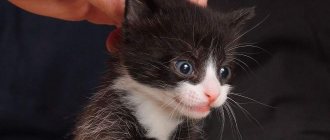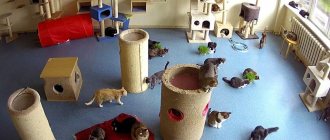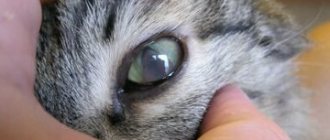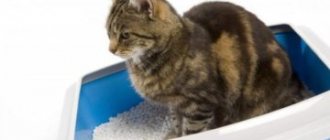How to care for a kitten at home
The formation of the body, health and life expectancy of an adult cat depend on proper care in the early period of life.
The formation of the body depends on proper care in the early period of life
Caring for newborn kittens
If the babies are with a cat, then the mother takes care of the offspring and the owner has few worries.
Need to control:
- "Nest" state. Clean the litter from wool and dirt.
- Weight gain. Newborns weigh approximately 120 g and, with normal development, gain 100 g weekly. Kittens grow a little faster than female cats. If the baby is growing more slowly, then he needs to be shown to the veterinarian.
- Condition of fur, eyes and ears. The coat should be dry and clean, and there should be no discharge from the ears and eyes. The cat's mother licks her offspring and healthy babies are always clean.
On the 8th day, the eyes open, by the end of the second week the babies begin to hear, and on the 20-21st day the kitten tries to walk.
There is no need to worry about newborns: the babies eat and sleep, actively gaining weight.
As soon as the baby opens its eyes, stands on its paws and begins to show interest in the world around it , the kitten needs to be picked up and stroked. Positive human contact will help the animal grow up affectionate and playful.
Care at 1 month
At this age, it is better not to take the baby away from its mother.
As soon as the baby opens his eyes, stands on his paws and begins to show interest in the world around him.
But if for some reason a month-old kitten is alone, then it will require special care:
- Feeding. The main diet should be milk. It is better to purchase a cat milk substitute at the veterinary store or dilute the dry milk by adding a little honey or sugar. Complementary foods (meat, porridge) are added in small doses. New food should be given in small quantities so as not to cause intestinal upset. You need to feed 6 times a day.
- Providing peristalsis. The cat licks the baby's tummy, stimulating intestinal function. To help the pet, the owner needs to moisten a cotton pad with warm water and massage first the sides and then the tummy in a circular motion from the sternum to the groin.
- Fresh water. If food is given on a schedule, then water should be in the bowl at all times.
Be sure to read:
At what age can a kitten’s claws be cut: why is it necessary, how often, description of the procedure
The animal must be toilet trained immediately. If the kitten begins to worry and “look for a place,” then you need to take it and put it in the tray.
You need to be persistent if the baby tries to run away and refuses to “do his business” in the designated area. The procedure must be carried out several times until the small pet understands where to defecate.
If your pet refuses to go to the litter box, then perhaps he is frightened by the large granules of the filler or does not like the consistency. By changing the toilet filling, you will be able to cope with the problem.
At this age, you should begin to accustom long-haired kittens to brushing. It is better to purchase a soft brush that detangles the fur and does not scratch the skin: then the combing procedure will be perceived as a pleasure by your pet.
Essentials
Before you bring a newborn or older kitten home, you should purchase a tray with filler, food bowls, a scratching post, toys, grooming tools, bedding, and a carrier. Most of these items will also be needed to care for an adult cat, so you should choose them responsibly.
global $ads_google; //data-ad-slot=”2475549904″ $ads_google = empty($ads_google) ? false : true; ?> if ($ads_google == false) {?>
$ads_google = true; ?> } ?>
Tray
Even if the cat is expected to be outdoors in the future, a small kitten will need an indoor litter box. If the grown pet does not leave the house, the tray will remain a permanent place for him to cope with his daily needs. Therefore, the toilet container should initially be convenient for use and cleaning. All modern models of trays are divided into two types: closed and open. The design of the latter assumes the presence or absence of filler.
Open trays with grids are not filled with absorbent material. They allow you to save on filler. But such toilets require timely cleaning, otherwise the air in the house accumulates a specific odor. If the container is filled with filler, the problem partially disappears, since most materials have adsorption properties.
Closed trays look like a house. They use special fillers that absorb the smell of urine and do not leave marks on the paws. An enclosed litter box is convenient in the home as it looks aesthetically pleasing and does not create problems caused by the unpleasant odor from cat feces. A characteristic feature of a closed tray is its large size, so it can be difficult to find a place for it in the apartment. Another disadvantage of such products is the high price.
The baby must be toilet trained from the first days of life in the house; postponing this moment of education until “later” can create unwanted problems.
Tray filler
Cat litter for the litter tray differs in composition. This determines their appearance and principle of operation. According to the last criterion, toilet material is divided into two types: clumping and absorbent. When wet, particles of clumping filler stick together into lumps. After they are removed, a new portion is added to the container. This filler is completely replaced every 5-7 days. The composition of clumping varieties can be different, most often these are clay minerals:
- vermiculite;
- atapulgitis;
- bentonite.
It is recommended to use clumping clay litter only when the kitten grows up. This is explained by the fact that babies often taste everything, and mineral lumps that get into the stomach can cause health problems. In addition, wet particles stick to the paws. For small cats, a litter made from ground corn cobs, paper, and wood is desirable. If such lumps enter the intestines, they come out naturally without causing harm to health.
The absorbent filler, unlike ordinary sand, consists of large or small granules with high adsorption capacity. Once wet, the liquid is quickly absorbed by the material, leaving the bottom of the tray dry. The composition of the material can be very different:
- clay minerals;
- blotters (clay with paper);
- wood pellets;
- wood shavings;
- silica gel;
- corn granules.
When caring for a kitten, this material is changed every time the pet goes to the toilet. The choice of filler is determined not only by the characteristics of the constituent components, but also by the preference of the kitten itself. If for some reason the material causes aversion in a young cat, then it is worth trying a different variety.
Choosing a place for the toilet
global $ads_google; //data-ad-slot=”2475549904″ $ads_google = empty($ads_google) ? false : true; ?> if ($ads_google == false) {?>
$ads_google = true; ?> } ?>
Most often the tray is placed in the bathroom or toilet. In this case, the problem with the smell and not very aesthetic appearance of the accessory after the cat has visited it is solved. But in this case, care must be taken to ensure that access to the bathroom is always open to the small pet. In some cases, the container is placed in the hallway. This is convenient for a cat, but not always comfortable for a person. The compromise in this situation is a closed tray.
scratching post
A cat's growing claws need constant sharpening. If the scratching post is not prepared, then damage to the upholstered furniture in the house is guaranteed. Various types of devices help satisfy a cat’s reflex in sharpening its claws. This can be a board attached to the wall, covered with a soft thick fabric, or a vertical post with sisal thread wound around it. The working area of the scratching post should be at a height accessible to the baby.
To accustom a kitten, it is recommended that you first bring it to this accessory and place its paws on a rough surface. You can additionally spray your homemade sharpener with catnip. The pleasant smell will attract the kitten to the device and gradually it will get used to sharpening its claws in this particular place.
Dishes
The rules for caring for a kitten dictate the need to select three bowls for food. The first is for water, the second is for dry food, the third is for wet or liquid food. The quality of the material from which the dishes are made remains at the discretion of the owner. It can be plastic, metal, ceramics, glass. The main thing is that the bowls are durable, without chips or cracks.
Another necessary condition is the stability of the containers. A bowl that slides on the floor will make your cat uncomfortable while eating. To avoid discomfort, it is advisable to choose plates with a stable platform, the surface or rim of which has an anti-slip coating.
When buying plastic dishes, you need to make sure that they do not emit harmful substances (phthalates), which can cause acne in cats.
Toys
Fluffy babies love to play, so you need to prepare a variety of toys and activities for them. Both ready-made and home-made products are suitable for the game. Pet stores offer a wide selection of jumping, rolling, and moving toys. It is important that they meet several requirements.
Firstly, the toy should not be too small, otherwise an inexperienced baby may swallow it. Secondly, only light objects that a weak kitten can move are suitable for play. Thirdly, the product should not be too hard so that a growing cat does not break its teeth when biting it.
If your kitten has to play alone, buy sound toys for him - they will create a feeling of feedback.
Hygiene and grooming items
global $ads_google; //data-ad-slot=”2475549904″ $ads_google = empty($ads_google) ? false : true; ?> if ($ads_google == false) {?>
$ads_google = true; ?> } ?>
Hygiene procedures are mandatory for cats of any age. Caring for a kitten includes brushing the fur, cleaning the ears and eyes, and bathing. The teeth and claws of the animal are not ignored. For all care activities, it is necessary to prepare a set of tools and products.
To keep your cat's fur in perfect condition, you will need combs in the form of a brush, comb, or mittens. For a long-haired pet, the kit is completed with a slicker brush and a tangle cutter. Kittens of short-haired breeds are combed once a week, long-haired ones - up to three times. During molting, this procedure is repeated daily.
For detergents, buy hypoallergenic shampoo (preferably with a conditioner effect). When the baby reaches the age at which bathing is allowed, these hygiene items should already be at the ready. You can also keep the coat in a clean, beautiful condition using grooming sprays. They clean hair from dirt, make combing easier and allow you to do without water procedures.
To care for a kitten you will need cotton pads and swabs, hydrogen peroxide. Using these accessories, the cub's ears are cleaned once a month.
How to care for kittens without a cat
It is better to purchase a cat's milk substitute.
It happens that the mother dies during childbirth, and the owner is left with blind, squeaking offspring.
The owner will have to replace the kittens' mother:
- Heating. A heating pad with water heated to a temperature of 35°C, on which a soft mattress is laid, works well. It is not recommended to place newborns near heating devices or warm them with an infrared lamp. In the first case, this will cause overheating, and the use of lamps may affect vision when babies open their eyes.
- Feeding. It is better to buy a cat's milk substitute, but if this is not possible, you can use cow's milk, adding a pinch of sugar. It is important not to feed formulas with a high percentage of fat in the first weeks. To give food, use a bottle with a nipple or feed with a pipette. Dishes are washed and sterilized after each meal. Feeding is carried out at intervals of 2-2.5 hours.
- Hygiene. To maintain cleanliness, the baby's fur must be wiped with a damp cloth. Bathing at an early age is prohibited. The ears are cleaned from accumulations of wax with a cotton swab, and to care for opened eyes, it is recommended to take an eye wash from a veterinary pharmacy.
- Stimulates digestion. After each meal, massage your tummy and sides in a circular motion from the chest to the perineum.
Be sure to read:
Reasons and ways to suppress a cat’s aggression and calm the animal down if it gets angry, meows, cries before bedtime
By the third week, kittens will begin to walk. In addition to feeding and care, you will need to pay attention to education: toilet training, showing a scratching post.
Kittens grow quickly and what is developed in the first days and weeks of life will become the basis for the behavior of an adult animal.
Caring for a one-month-old kitten
Nutrition. By the fifth week, the kitten already weighs 240-260 grams. For weight gain to be physiological, the feeding interval, starting from the fourth week, should be 3-4 hours. Food is provided only during the daytime. In addition to milk, the diet of a one-month-old kitten includes lean beef, turkey, canned food for kittens, and vegetable puree. All solid ingredients must be ground until homogeneous, because babies are not yet able to chew food.
global $ads_google; //data-ad-slot=”2475549904″ $ads_google = empty($ads_google) ? false : true; ?> if ($ads_google == false) {?>
$ads_google = true; ?> } ?>
Toilet. At 1 month, you can place a tray next to the bed. It is necessary to place the baby in the container after each meal. To begin with, you can put disposable absorbent diapers in the tray. After some time, filler is poured in instead. It is important to ensure that the kitten does not eat lumps and granules from the tray.
Hygiene. A one-month-old cat cannot be bathed yet. Care procedures consist of regular examination and washing of the eyes and ears. To do this, use a cotton pad soaked in warm water. Sometimes kittens experience watery eyes in the morning. If there are no suspicious purulent impurities in the discharge, then regular washing with water is sufficient.
When caring for a small kitten, you should pay attention to the gums. If they become red and swollen, a teething numbing gel should be used.
Choosing a place for a kitten's toilet
Cats try to satisfy their natural needs in an intimate environment, and the place chosen for the toilet in the apartment must meet a number of requirements:
- Availability. The kitten should be able to go to the litter box at any time.
- Privacy. Animals do not like to be looked at while they are emptying their bowels or bladder.
- Comfort. If the baby does not like the litter, then it is almost impossible to force him to go to the tray. It is recommended to take the pellets that were used by the breeder.
Familiar filler and a comfortable environment will allow the kitten to quickly get used to the new place.
Features of care
Little by little, the children grow up, their eyes open, and they begin to explore this new world. They really need care and proper care so that they grow up healthy and happy.
Per month
A one-month-old kitten requires a lot of care: it is weak, helpless and cannot provide for itself.
If the cat does not have enough milk or the kitten is left without a mother, it needs to be fed milk food using a syringe without a needle.
You can purchase special milk formulas and baby food for kittens. Their stomach will not digest cow's milk. A one-week-old kitten should be fed only with special mixtures, and from 1 month you can start feeding it. If you are planning a natural diet, then you can gradually teach your pet to eat from a bowl, grinding the food as much as possible.
When you plan to feed your cat prepared food, you can slowly introduce dry food into the diet, after soaking it in water.
In cases where the kitten does not have a mother, he needs to have a belly massage to help normal intestinal motility. The cat licks the kitten, massaging its belly, but if the baby has lost its mother, then its digestion must be helped. Such artificial licking procedures should be carried out from birth until the digestive tract starts working on its own.
You need to wash your eyes daily with a cotton swab dipped in water or a special solution. During this same period, it is already necessary to accustom the kitten to the tray.
When a homeless child appears in the house, he must be given anti-worm medications.
At two months
Nutrition should be continued in the same way as at one month of age. You can slowly diversify the diet with new foods that you plan to feed your pet.
The first vaccination is indicated for a two-month-old kitten. At this age, the first vaccination against the most common viral diseases of cats is given.
Rinse your eyes with furatsilin or chamomile decoction, brush your teeth daily, and ears once a month. Weekly brushing is also necessary. Claws are trimmed as necessary.
At 2 months you can carry out the first wash. You should carefully monitor the water temperature; it should not exceed 38 degrees. You should bathe your baby carefully so that water does not get into the ears. It's better not to get your hair wet at all.
At three months
By the age of three months, the kitten is already completely independent, all its systems are formed. If he is raised correctly, he is able to eat adult food on his own, play, and is litter box trained.
It is necessary to provide him with maintenance: give him the necessary vaccinations, protect him from injuries, feed him properly, care for his skin, coat, eyes, ears and claws.
At 3 months, you should continue training, accustoming the cat to order in the house.
Sterilization or castration is carried out within a period of 8 months to a year, until the animal’s reproductive instinct awakens.
Kittens without mother
If the kitten is left without a mother, it will have to be fed on its own. To do this, you will need a special mixture and a bottle with a nipple. After each feeding, as with small children, kittens must be provoked to burp. This is also done: the cat is placed on the shoulder, placing a hand under the tummy, and the back is stroked and rubbed.
Feeding should be on a schedule: every two or three hours. After reaching two weeks of age, feeding can be done less frequently: every three or four hours, and a break at night (no longer than 6 hours).
To stimulate intestinal peristalsis, kittens are given a light massage, simulating licking. After lunch, the cat should be held over the tray, wiping its crotch with a damp cloth (it is better not to use cotton pads, the fibers remain on the fur and skin). Movements should be made carefully, in one direction, so as not to damage the delicate skin.
After the kitten has emptied its bladder and bowels, you should pay attention to the color and consistency of the excrement. Urine should be light yellow in color.
If it is dark, this indicates a lack of moisture in the baby’s body.
The feces should be light brown or yellowish in color and have a dense consistency.
If the feces are green, this indicates excess nutrition, white ones indicate serious problems with digestion and absorption of nutritional compounds.
In this case, the baby should be shown to the veterinarian. You should also consult a doctor if your kitten does not defecate at all, and as soon as possible.
Until two weeks of age, a kitten's thermoregulation mechanisms do not work, so it should be kept warm. It is necessary to determine the warmest place for the cat in the house, without drafts; in addition, you can use an electric heating pad. Over time, the baby's body will begin to regulate its temperature, and he will move closer or further away from the heating pad.
You can tell if a kitten is cold by touching its ears, paw pads, or putting a finger in its mouth. If these places are cold, the animal must be immediately warmed up: wrapped in a warm, thick cloth and pressed against its own body.
Shelter kitten
Kittens are usually taken from a nursery or shelter at the age of two months. To make it easier for the baby to adapt to a new place, you should take a blanket or bedding where the smell of the mother and other kittens remains. A blind kitten can only navigate by smell for now, and he will feel calmer in his new home if he can smell familiar smells.
By the time the baby gets to a new home, all the necessary things should be prepared for him: food, dishes, tray, toys. At first, the small animal will demand a lot of attention, announcing itself by squeaking. At first, it is necessary to pay as much attention as possible to the new tenant. You should introduce him to the new space gradually in the same way as with the rest of the family. Lots of people, loud noises, and a lot of new and strong smells can cause serious stress in your pet.
The kitten is not able to contact other animals until two weeks old, so if there are other pets in the house, then you need to introduce them to the new inhabitant gradually and only after two weeks of age.
For kittens of different breeds
Some cat breeds require additional feeding from a very early age. Scots, both long-haired and short-haired, as well as all cats with long or semi-long hair (Siberian, Persian, Norwegian) require regular brushing and washing.
This is important to prevent the wool from matting into lumps and tangles.
Britons, who have short hair, do not need to be brushed often, but simply run your hands wet with water through their coat. Canadian, Don and other Sphynx cats do not have hair, so their skin requires additional care. Such cats need to be washed regularly and their skin wiped with special solutions. Be sure to provide the sphinx with a warm bed.
Kitten nutrition
How to care for a kitten
It is better to feed the baby on time, with even intervals between meals:
- up to 2 months – 5 times;
- by the age of six months, the frequency of feedings gradually decreases to 3 times, and the portion gradually increases;
- An eight-month-old animal is fed like an adult - twice a day.
Your pet's diet must include:
- raw beef;
- boiled chicken meat;
- milk porridge;
- egg yolk;
- raw and boiled vegetables;
- fermented milk products.
You cannot feed food from the human table: salt and spices are harmful to the cat’s body.
Be sure to read:
Which mat cutter is best for cats: straight, curved, how to use it, how much it costs
Veterinarians recommend purchasing balanced cat food for kittens, taking into account age. Specialized mixtures contain all the necessary elements necessary for the growth of a pet.
Care for 3 months and older
Nutrition. The diet of an adult fluffy during this period is very varied: meat, fish, milk, cottage cheese, egg yolk, cereals, vegetables, cereals (except corn). Food can be offered in bite-sized pieces. But you cannot put the entire daily amount of food into a bowl at once. The pet has not yet learned to clearly control its appetite, so it may eat too much. The norm for one feeding is 200 grams per 1 kg of animal weight. At 3 months, a kitten eats 400 grams of food per day, and at 4 months – 600 grams.
Natural food and wet food should be warm.
Hygiene. Caring for a kitten includes the usual set of hygiene procedures, which is complemented by brushing teeth. By the age of four months, all of the cat’s teeth have erupted, so prevention of dental problems in domestic hermits is mandatory. Teeth are cleaned using small brushes and a paste with a pleasant smell.
global $ads_google; //data-ad-slot=”2475549904″ $ads_google = empty($ads_google) ? false : true; ?> if ($ads_google == false) {?>
$ads_google = true; ?> } ?>
Vaccination. At 3 months the cat is vaccinated a second time. Revaccination includes the same drugs that were used a month ago. The next vaccination is scheduled after a year. After the procedure, you should carefully monitor your pet's well-being. If you notice apathy or restlessness, fever, sneezing, swelling in the injection area or other suspicious symptoms, you should contact a veterinary clinic.
The exciting period for the owner of caring for a kitten passes quickly. But if the pet is surrounded by care and attention, then many problems bypass it. Kotofey grows and develops according to his age and enters adulthood healthy and cheerful.
Toys and other things for development and communication with a kitten
All children love to play, and felines are no exception. Having settled in a new place, the baby begins to enjoy running after a piece of paper on a string or chasing various objects across the floor.
It is better to make sure that the kitten has its own things:
- Movable toys. Fur balls, rubber mice and other similar things. It is important that toys do not have small parts: kittens are teething, the baby can bite off a small part and choke.
- Hanging objects. A ball hanging on a thread on the door handle will occupy the attention of a cat child for a long time.
- Scratching post. Sharpening claws is a natural need of the cat tribe. If you do not acquire this useful item, the furniture or carpet will suffer. In the first days, you need to show your pet a place where it is allowed to sharpen its claws.
A good option would be to purchase a special complex where your pet can climb and jump.
In addition to the fact that the device develops the cat's dexterity and flexibility, purchasing a device will reduce the likelihood that a playful baby will throw flowers from the windowsill or objects from the table.
Games
Games allow cats to realize their hunting instinct and throw out excess energy, which helps save property and repairs. Most pets prefer fishing rods with feathers and mice, but some like balls, bouncy posts, mazes and other accessories. When choosing, you should start from the preferences of your pet. Play sessions should be short but frequent. It is advisable to pay attention to your companion at least 2-3 times a day.
Interactive toys are suitable for those pet owners who are away from home for a long time
You cannot play with the kitten with your hands and feet. Later, an adult cat will do the same and can injure the household. The most dangerous games are those that the pet imposes on itself. For example, hunting for legs. Such activities should be stopped immediately. Feeding and play must be initiated by the owner, otherwise the pet may decide that it occupies the highest status in the hierarchical ladder.
Common Mistakes
Raising cats is not an easy process. Most animal owners lacking experience make common mistakes in the process of teaching their four-legged friend commands, which negatively affect the development of the kitten’s character. Below you can find the most common mistakes that should be avoided when raising an animal.
- Treat your four-legged friend aggressively, pull him by the scruff of the neck, and harshly poke his muzzle into the place where he relieved himself. You should not raise your voice, as such behavior will cause the baby to become excessively timid.
- You cannot deprive your cat of attention and affection. An animal at any age needs the care of its owner. If you deprive him of love and attention, the pet may start going to the toilet in the wrong place for the purpose of revenge.
- Saving on purchasing personal items for the kitten. It is very important that your pet has a bed, toys, a comfortable tray and other care items. This will allow you to raise the animal faster. For example, it is much easier to teach a cat to go into a comfortable tray than into a tray with too high sides.
Even a sphinx can be taught commands if you put in the effort
Kittens, like small children, need not only care, but also education. By following the tips described above on how to properly raise a kitten, you can raise an intelligent and obedient pet. The most important thing when raising a dog is not to raise your voice or hit the animal.
At what age is a kitten taken to a new home?
Caring for a one-month-old kitten is the most problematic. Don’t rush to take home the little lump you like immediately after meeting him. There is a chance that he needs a little more time to gain strength before moving to a new home.
Perfect time
The optimal age for separation from a mother cat is 2.5-3 months. From this moment on, her cubs switch to a normal diet, so the stress from the sudden loss of a beloved breast will be minimal.
It is also important for the future owner that the appearance of a three-month-old cat is unlikely to change. Small variations are only acceptable among a limited range of breeds, including the Siamese. These snow-white beauties will gradually darken for almost a year, so be sure to capture such a unique moment with a series of photographs.
Help getting used to a new home
Unlike adults, small pets quickly adapt to a new place and get used to their owners. But don’t be surprised that in the first days the baby will miss his mother a lot. Puzzled by her search, he can turn the entire apartment upside down, so remove all dangerous objects from his path in advance.
For easier adaptation, it is recommended to take something from a nursery or shelter that is saturated with a familiar smell. Its aroma can calm the cat in moments of sadness.
Getting to know new family members should happen gradually. If there are other cats in the house, be sure to make friends with them to avoid conflicts in the future. Let your pets get used to each other's scent from a distance and only then bring them nose to nose.
Hand training
Hand training begins at an early age. The babies are petted and offered permitted treats. This allows you to form positive associations. You can only pick up a kitten if it does not protest. Overly intrusive attempts at training can cause a negative reaction.
I had experience in breeding cats and from my impressions I can say that not all pets like to sit in their arms. You just have to accept it. You can correct the kitten’s reaction if you do not behave intrusively and make it clear that you can be trusted, but if the cat categorically does not like such tenderness, it is unlikely that it will ever change its mind. Some kittens are very affectionate from childhood and constantly strive to get into your arms, others prefer to keep their distance. The latter are less intrusive, which can also be called an advantage. In any case, even those cats that do not like to be held can be very affectionate.
What should a kitten eat?
What is not prohibited is permitted. There are a great many prohibitions in this area. For example, you shouldn’t even think about milk, which many consider the ideal cat food. The animal’s body is not able to digest it, and the owners will constantly have to remove the consequences from the tray.
In addition to milk, cats are prohibited from eating:
- bones;
- pork, duck or goose;
- sausage;
- smoked;
- salty;
- sweet;
- potato;
- beans;
- fish;
- egg white.
What can a kitten eat:
- raw frozen beef meat;
- boiled chicken;
- offal;
- egg yolk;
- dairy products;
- porridge;
- boiled or raw vegetables.
When should you start parenting?
How to raise a kitten and when to start this process? During the period when the kitten is small, its personality is formed. At this moment, his habits are not defined. You can easily adjust his preferences and lifestyle.
Training a cat is one of the main tasks of every owner.
Important! An adult animal is difficult to train.
You should not buy a kitten that is too small. Until the pet reaches 3 months of age, it is not recommended to take the baby away from its mother, because it is during this period that he needs maternal warmth and upbringing. In the first months, a mother cat teaches her baby the ability to hunt, keep her fur clean, and play. Natural upbringing helps in the future to easily adapt to environmental conditions.
Education should begin from the moment the baby is brought into the house. The most important thing is to behave calmly and not take it out on the animal. Otherwise, the kitten will become afraid of people and, of course, refuse to comply with their demands.
Note! Raising a kitten at 2 months will not give the desired result; it is better to wait a little until the baby grows up.











